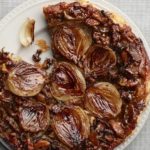Sarah Mellersh’s Onion Tarte Tatin
Continuing the vegetarian theme, I turned for inspiration, as I so often do, to a thick red folder from Let's Cook Scotland. As many of you are aware, that's where I spent a game changing fortnight under the

Sarah Mellersh
tutelage of the very lovely Sarah Mellersh. There are hundreds of recipes in the book - and they work. They're categorised into a couple of dozen sections, the vegetarian one readily coming to hand. First recipe, tartiflette. Great! Haven't made that in ages. A hearty Alpine dish with potatoes, onions, cheese and, er, bacon. As the last recipe is for lentils with chorizo, I can say that Sarah is a much better cook than she is a librarian.
But a couple of pages on I came to this beauty. You will need a 23 cm heavy pan. A baking sheet is also recommended, to catch any sticky drips which are a real sod to get off your oven. Do take extreme care at all stages, as the possibility of serious burns is a real one. If Ms Dubois (the Edinburgh one) is reading this, note the type of pastry used by a professional.
Ingredients (serves six as a starter or four as a main course)
1.15 kg onions, red or normal (seems an odd quantity. I suspect it's a conversion from a metric recipe); 25g butter; 1 teaspoon caster sugar; six sprigs of thyme; 1 tbsp chopped fresh thyme; 1 tbsp balsamic vinegar; 200g puff pastry; s & p.
(seems an odd quantity. I suspect it's a conversion from a metric recipe); 25g butter; 1 teaspoon caster sugar; six sprigs of thyme; 1 tbsp chopped fresh thyme; 1 tbsp balsamic vinegar; 200g puff pastry; s & p.
*******************************************
Pre-heat the oven to 180°C/ Mark 4.
Cut the onions in half lengthways from stem to root. Place the pan over a medium heat. When it's hot add the butter and the sugar. As soon as the butter begins to sizzle, scatter the sprigs of thyme in, then arrange the onions on the base of the pan cut side down, filling in any gaps. Bear in mind that what you see when you turn the tart out is the cut side of the onions. Give them a good seasoning of salt and pepper, then scatter over the chopped thyme and sprinkle on the vinegar. Turn the heat down and let the onions cook very gently for about 10 minutes, stirring occasionally.
After that, cover the pan with foil and place it on a baking sheet on the shelf in the centre of the oven and leave it there for the onions to cook for 50 to 60 minutes. Test them with the tip of a knife. They should be cooked through, but still remain some texture. Remove the pan from the oven and put it back on the hob on a medium heat. Increase the oven temperature to 200°C/Mark 6. On the hob, reduce the buttery onion liquid. This will take about 10 minutes, but take care not to allow it to burn. You should be left with very little syrupy liquid at the base of the pan.
Roll out the pastry to a circle about 25 - 26 cm in diameter. Turn the heat off the pan and fit the pastry over the onions, pushing down and tucking in the edges all around the inside of the pan. Mind your fingers - a table knife is recommended. Return the pan to the oven on top of the baking sheet. Cook for another 25 to 30 minutes until the pastry is crisp and golden.
When the tart is cooked, remove it from the oven and allow it to cool for 20 minutes before turning it out. This is the second dangerous part. It will still be very hot When turning it out, it is important to have a completely flat plate or board. Place the plate on top of the pan and turn it upside down, giving a good shake. Any onions left in the pan? Just lift them off with a pallet knife and replace them into their own space in the tart.
Yes, she is of course reading your words. More in sorrow than in anger, I refer you to Delia’s Winter Collection. Dame Delia knows her onions.
Bought in pastry…well, to channel Miss Jean Brodie “ for people who like that sort of thing – that’s the sort of thing they like.”.
Citing Jean Brodie as a role model, eh? You can tell that the lady lives in Murrayfield.
Sounds delicious, Tom. I made a tomato tarte Tatin recently and it was really well received.